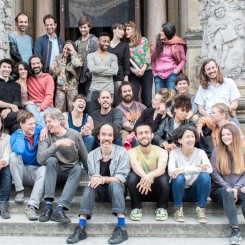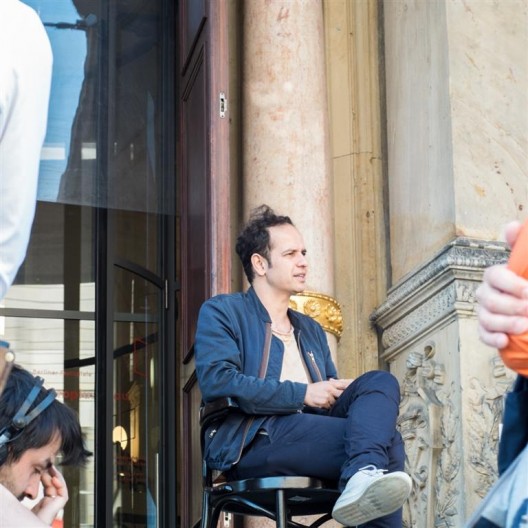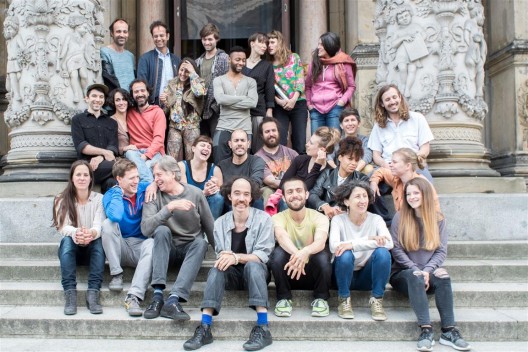Tino Sehgal’s Berlin Retrospective
Martin-Gropius-Bau (Niederkirchnerstraße 7, 10963 Berlin, Germany), Jun 28 – Aug 8, 2015
Tino Sehgal’s exhibition at Berlin’s Martin Gropius Bau eschews banalities such as titles, descriptions or work lists. At times whimsical, discomforting and engaging, the artist’s first retrospective assembles over 60 actors to perform five-and-a-half works in the otherwise empty halls of the museum. When I first enter the large central hall, a couple lies entwined in the middle of the floor, kissing—re-enacting famous art-historical embraces. (“The Kiss”, 2002). Stay awhile though, and a new line of performers files in from somewhere off-stage. They loll against pillars and mingle with the gallery visitors, distractedly gazing at the lovers until drifting into an a-cappella song group, intoning melodies which owe a debt to Steve Reich’s and Phillip Glass’s polyphonic serialism. Sehgal’s work, in this case, hovers somewhere between kitsch and the sublime: while the concept is straightforward, the ambiguous positions of the observers—it is never clear whether they are participants or mere visitors—heightens the piece.
The free-flowing movement and lack of barrier between subject and performer—it is never evident who is a participant in the performance, and the audience is encouraged to take on an active role in many pieces—is characteristic of Sehgal’s work, and show his debt to Relational Aesthetics, the 90’s art movement that emphasised human relations and their social context.
Born in 1976 in London, the English/German artist credits the development of his free-flowing “situations”, which exist independently of any notion of stage, fourth wall (the theatrical concept that describes the invisible barrier between actors and audience), or fixed duration to the experimental theatre of Christoph Schlingensief and Einar Schleefs he witnessed in Berlin during the early 90s. It was the promise of the flexibility and flat hierarchies of the museum space that drew the student of economy and dance from the theatre to the art gallery. Shown at Tate Modern, the Guggenheim, the Venice Biennale and Documenta, among other venues, his “situations”, disrupt the reverie of the gallery visit with conversation, song and movement. The artist refuses to photograph or document his work, claiming that this would render his ephemeral performances too object-like and too marketable.
“This Variation” (2012), a situation from the 13th edition of “documenta”, the German art quintennial, takes place in a room that is almost, but not quite, pitch black. Slowly, as your eyes adjust to the darkness, you become aware of shapes moving around you, singing a-cappella pop songs and beat-boxing, creating an immersive soundscape. Sehgal’s works exist in a space of their own, hovering between theatrical performance and studied improvisation, with his dancers and singers rehearsing for up to two years for a piece. While Sehgal emphasised that audience members are welcome to join in with the singing and clapping of “This Variation”, he quickly added (at the press conference for the exhibition) “but only if you clap in time”. In other pieces (“Welcome to this Situation” and “Ann Lee”) the actors interact directly with members of the audience.
Sehgal’s playfulness comes to the fore in in “Ann Lee” a “situation” enacted by a pair of uncanny child actresses. By her own account, she is the 3D embodiment of the eponymous Anime character “owned” by the artists Pierre Huyghe and Phillippe Parreno, who have lent her to Sehgal. His play with format and narrative embodiment makes for intriguing viewing, particularly when the character relays her release from her two-dimensional entrapment. Towards the end of the monologue, she stares down visitors and inquires: “Would you rather be too busy, or not busy enough”? But she doesn’t wait for an answer.
In “Welcome to this Situation” the audience is invited to debate questions on progress, capitalism, technology and social change with a panel of around seven actors. The actors are indistinguishable from the audience. The participation that afternoon was tenuous, and four weeks into the exhibition, I wondered how tired the actors were of their debate.
“Ann Lee”, the aforementioned Anime character, is perhaps the exhibitions most self-reflexive piece. At one point she remarks “I like art and the places it is shown”, and I couldn’t help but think that this comment referred to Sehgal’s work in and of itself: sited firmly in the art world and its institutions, it nevertheless refuses to conform, with performances questioning roles of participant and observer, of subject and visitor. Sehgal’s works in this exhibition both highlights his debt to relational aesthetics and expands on this form of artistic practice: at times, the visitor’s position as observer is genuinely overcome, and she becomes a participant in Sehgal’s elaborately staged Situations. Each work was tied to a single room and framed as such: the absence of wall texts thus did not matter much. The exhibition showed the breadth of Sehgal’s oeuvre, varying as it did between song-performance, political debate, and art historical appropriation.
Much has been made of Sehgal’s refusal to produce physical remnants of his work; nevertheless, he has achieved enormous institutional recognition for his theatricality and mise en scène. Sehgal’s critique of the art world paradoxically only achieves its full effect within just such a context: his refusal of items such as wall texts with work titles and years, press releases, photographs and other forms of documentation only function fully in an environment where such items are otherwise present. To view his works in the Martin-Gropius-Bau—a multi-purpose building used for anything from Viking exhibitions to photography retrospectives—is to deprive them of some of their power.


